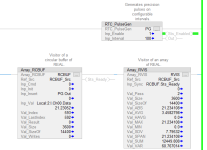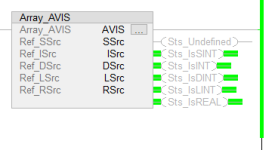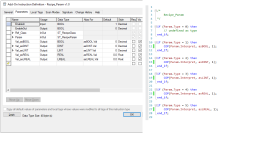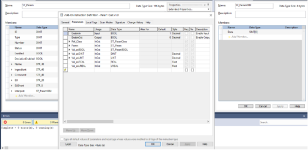JeremyM
Lifetime Supporting Member
I've been banging my head for a way to generalize data handling in a meaningful way in Logix. What I've concocted so far is the idea of "visitors" to an array that perform tiny roles.
Enter RVIS. This block does all the statistical math on a variably-sized array in a single scan pass. Each scan, it advances exactly one element in the array until reaching the end of the data, then does the math at once to keep the scan time down most of the time.
It can be told to calculate immediately, though...
Enter RCBUF. This block implements the activities of a circular buffer on a variably-sized array. It accepts a command to insert a new element from some command source (fixed pulse generator in this case). When it takes care of the insertion, it raises its Ready signal which is fed to RVIS to coerce a math update.
Does this have potential or are we looking at a heap of madness?

Enter RVIS. This block does all the statistical math on a variably-sized array in a single scan pass. Each scan, it advances exactly one element in the array until reaching the end of the data, then does the math at once to keep the scan time down most of the time.
It can be told to calculate immediately, though...
Enter RCBUF. This block implements the activities of a circular buffer on a variably-sized array. It accepts a command to insert a new element from some command source (fixed pulse generator in this case). When it takes care of the insertion, it raises its Ready signal which is fed to RVIS to coerce a math update.
Does this have potential or are we looking at a heap of madness?










